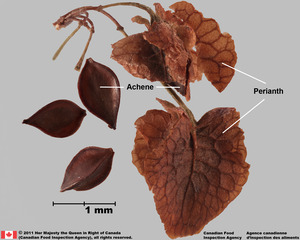Family name: Dasypogonaceae Dumort.
Synonym(s): Baxteriaceae Takht.; Calectasiaceae Schnizl.; Kingiaceae Endl. ex Schnizl.
Common name(s): dasypogon family
*Number of genera/species: 4/16
List of genera records in GRIN-Global
fruit or rarely, seed
Fruit an acheneachene:
a dry, indehiscent, one-seeded fruit, with seed attached to pericarp at a single point, derived from a single, superior, simple or compound, one-loculed ovary , rarely loculicidalloculicidal:
, rarely loculicidalloculicidal:
type of capsular dehiscence, opening longitudinally through the locules (compare septicidal)
 and septicidalsepticidal:
and septicidalsepticidal:
type of capsular dehiscence, opening longitudinally by separating between the septa of adjacent carpels
 capsulecapsule:
capsulecapsule:
a dry, dehiscent fruit derived from a compound ovary with explosive dehiscence (Baxteria), up to 15 mm long, ovoidovoid:
with explosive dehiscence (Baxteria), up to 15 mm long, ovoidovoid:
3D shape—ovate , tereteterete:
, tereteterete:
approximately circular in cross section; width and thickness approximately equal
 or triangulartriangular:
or triangulartriangular:
2D shape—three relatively straight sides with distinct corners; more angular than teardrop-shaped in transection. AchenesAchene:
in transection. AchenesAchene:
a dry, indehiscent, one-seeded fruit, with seed attached to pericarp at a single point, derived from a single, superior, simple or compound, one-loculed ovary one seeded with persistent hardened perianthperianth:
one seeded with persistent hardened perianthperianth:
collective term for calyx and corolla of a flower
 . CapsulesCapsule:
. CapsulesCapsule:
a dry, dehiscent fruit derived from a compound ovary less than 10-seeded. Pericarppericarp:
less than 10-seeded. Pericarppericarp:
fruit wall or fruit coat
brown, glabrousglabrous:
without hairs
or pubescentpubescent:
surface relief—bearing hairs
, smooth.
Seeds globoseglobose:
3D shape—more or less spherical or oblongoblong:
or oblongoblong:
2D shape—much longer than broad with nearly parallel sides, corners are rounded , tereteterete:
, tereteterete:
approximately circular in cross section; width and thickness approximately equal
 in transection, 2–4.5 mm long. Seed coat yellow to brown.
in transection, 2–4.5 mm long. Seed coat yellow to brown.
Embryo small, lens-shapedlens-shaped:
2D shape—round and flattened with two curved (convex) surfaces
or broad, curvedcurved:
(of embryo) linear embryo is curved into an arch or horseshoe with the ends far apart or straight, basalbasal:
or straight, basalbasal:
at or pertaining to the point of attachment; (of embryo) embryo occupies one end of the seed
.
Endosperm copious.
| Fruit | |
| Type | acheneachene: a dry, indehiscent, one-seeded fruit, with seed attached to pericarp at a single point, derived from a single, superior, simple or compound, one-loculed ovary  , loculicidalloculicidal: , loculicidalloculicidal:type of capsular dehiscence, opening longitudinally through the locules (compare septicidal)  and septicidalsepticidal: and septicidalsepticidal:type of capsular dehiscence, opening longitudinally by separating between the septa of adjacent carpels  capsulecapsule: capsulecapsule:a dry, dehiscent fruit derived from a compound ovary  |
| Size range | 15 mm long |
| Shape(s) | ovoidovoid: 3D shape—ovate  |
| Surface relief | smooth |
| Color(s) | brown |
| Unique features | AchenesAchene: a dry, indehiscent, one-seeded fruit, with seed attached to pericarp at a single point, derived from a single, superior, simple or compound, one-loculed ovary  with persistent hardened perianthperianth: with persistent hardened perianthperianth:collective term for calyx and corolla of a flower  . Or, few seeded, smooth, capsulescapsule: . Or, few seeded, smooth, capsulescapsule:a dry, dehiscent fruit derived from a compound ovary  sometimes pubescentpubescent: sometimes pubescentpubescent:surface relief—bearing hairs . |
| Seed | |
| Size range | 2–4.5 mm long |
| Shape(s) | globoseglobose: 3D shape—more or less spherical  , oblongoblong: , oblongoblong:2D shape—much longer than broad with nearly parallel sides, corners are rounded  |
| Other | |
| Embryo | small, lens-shapedlens-shaped: 2D shape—round and flattened with two curved (convex) surfaces or broad, curvedcurved: (of embryo) linear embryo is curved into an arch or horseshoe with the ends far apart  or straight, basalbasal: or straight, basalbasal:at or pertaining to the point of attachment; (of embryo) embryo occupies one end of the seed . |
| Nutritive tissue | endosperm copious |
Southwestern Australia.

Distribution map courtesy of Angiosperm Phylogeny Website.
Baskin and Baskin 2021Baskin and Baskin 2021:
Baskin C and Baskin J. 2021. Relationship of the lateral embryo (in grasses) to other monocot embryos: A status up-grade. Seed Science Research 31 (3): 199-210. doi:10.1017/S0960258521000209; Dahlgren et al. 1985Dahlgren et al. 1985:
Dahlgren RMT, Clifford HT, and Yeo PF. 1985. The families of the monocotyledons: structure, evolution, and taxonomy. Springer-Verlag, Berlin. 520 pp.; Kirkbride et al. 2006Kirkbride et al. 2006:
Kirkbride JH, Jr, Gunn CR, and Dallwitz MJ. 2006. Family guide for fruits and seeds, vers. 1.0. Accessed September 2020-January 2022. URL: https://nt.ars-grin.gov/seedsfruits/keys/frsdfam/index.cfm .; Kubitzki et al. 1990+Kubitzki et al. 1990+:
Kubitzki K et al., eds. 1990+. The families and genera of vascular plants. 7+ vols. Berlin etc.; Rudall and Conran 2012Rudall and Conran 2012:
Rudall PJ and Conran JG. 2012. Systematic placement of Dasypogonaceae among commelinid monocots: evidence from flowers and fruits. Botanical Review 78 (4): 398-415. https://www.jstor.org/stable/41809860; Stevenson and Loconte 1995Stevenson and Loconte 1995:
Stevenson DW and Loconte H. 1995. A cladistic analysis of monocot families. In: Rudall PJ, Cribb PJ, Cutler DF, and Humphries CJ, eds. Monocotyledons: Systematics and Evolution. Royal Botanic Gardens, Kew.
*The number of genera and species is based on Christenhusz and Byng 2016Christenhusz and Byng 2016:
Christenhusz MJM and Byng JW. 2016. The number of known plant species in the world and its annual increase. Phytotaxa 261 (3): 201-217. https://doi.org/10.11646/phytotaxa.261.3.1, which may differ from the number of genera in GRIN-Global.